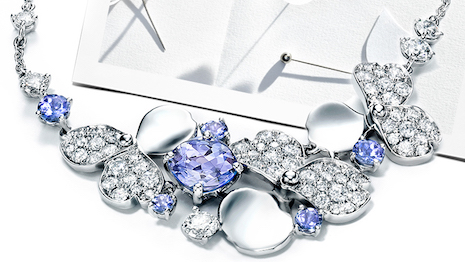 Chinese actress Yang Mi modeling Michael Kors. Image credit: Michael Kors
Chinese actress Yang Mi modeling Michael Kors. Image credit: Michael Kors
Chinese ecommerce sales have surpassed $1 trillion for the first time, with no signs of sales or growth slowing down for the world's largest digital retail market.
The Chinese ecommerce market must be of increasing importance to luxury retailers as it continues to pull away from the United States in terms of value. According to Digital Commerce 360, in 2017 online purchases by Chinese consumers reached $1.12 trillion, or 7.18 trillion yuan at current exchange, a 32 percent jump from 2016's $869 billion in sales.
Chinese consumers’ have a proven appetite for fashionable and trendy goods sourced from Western countries and purchased primarily on their mobile devices," said Nancy Zhang, manager and head of partnerships at BorderX, New York. "The growth in the market is explosive."
Luxury online
Within the next five years, Forrester expects China's online retail sales to reach $1.8 trillion. Ecommerce giants Alibaba and JD.com account for more than 85 percent of all online sales in China.
To better serve luxury brands, Alibaba's Tmall launched an invite-only platform, Luxury Pavilion, in late 2017.
 Valentino is part of Alibaba's Luxury Pavillion. Image credit: Alibaba
In keeping with the luxury theme, the platform allows brands to create much more robust and unique experiences that match with the luxury shopping experience in-store but applying it to a digital space (see story). More than 100,000 of Luxury Pavilion’s customers spend $159,000 or more a year.
Today, Luxury Pavilion sells merchandise from almost 50 luxury brands, including Burberry and Maserati. Through the new Luxury Pavilion Club loyalty program, shoppers will gain access to perks such as exclusive offers, celebrity events and door-to-door returns.
Reflecting the growing importance of younger generations to the luxury market, half of shoppers across Alibaba’s platforms were born after 1990. This age group also accounts for one-third of Luxury Pavilion’s customer base (see story).
Jeweler Tiffany & Co. and Italian fashion house Valentino are among the luxury brands that have patterned with Luxury Pavilion for special pop-up sales events.
Valentino is part of Alibaba's Luxury Pavillion. Image credit: Alibaba
In keeping with the luxury theme, the platform allows brands to create much more robust and unique experiences that match with the luxury shopping experience in-store but applying it to a digital space (see story). More than 100,000 of Luxury Pavilion’s customers spend $159,000 or more a year.
Today, Luxury Pavilion sells merchandise from almost 50 luxury brands, including Burberry and Maserati. Through the new Luxury Pavilion Club loyalty program, shoppers will gain access to perks such as exclusive offers, celebrity events and door-to-door returns.
Reflecting the growing importance of younger generations to the luxury market, half of shoppers across Alibaba’s platforms were born after 1990. This age group also accounts for one-third of Luxury Pavilion’s customer base (see story).
Jeweler Tiffany & Co. and Italian fashion house Valentino are among the luxury brands that have patterned with Luxury Pavilion for special pop-up sales events.
 The Tiffany Paper Flowers collection premiered on Luxury Pavilion. Image credit: Alibaba
China's youngest affluents rely on their smartphones to get around the Great Firewall to access social media and international news. Chinese social media applications, including Weibo and WeChat, are also an important way for luxury brands to reach younger affluents.
As luxury brands look to attract high-spending Chinese millennials, a streamlined, mobile-first shopping experience and product recommendations should be two priorities.
Chinese shopping recommendation site Dealmoon has integrated cultural preferences, such as user reviews, luxe packaging and smaller size availability, into its ecommerce platform to draw in Chinese affluents (see story).
Mobile matters
More than three-quarters of all ecommerce in China is done with mobile devices, including mobile payments. Eighty percent of metro Chinese shoppers completed online purchases with Alipay and 66 percent used WeChat Pay, per Forrester.
As Chinese consumers now account for 32 percent of spend on luxury goods worldwide, even luxury retailers in the U.S. need to focus on catering to them by understanding the culture and adopting mobile trends. Many do most of their spending overseas, including stateside.
Speaking at the Luxury Marketing Forum, the CEO of Attract China detailed the importance of catering to affluent Chinese travelers, explaining China will be the top source of visitors in North America by the year 2020. These travelers spend an average of $7,200 per individual, likely reaching a total of $61.5 billion by 2020 (see story).
Chinese affluent look to purchase luxury goods while traveling abroad, and Chinese consumers spend the most out of any group while traveling. YouGov's Affluent Perspective 2017: Chinese Luxury Shoppers in America finds that 56 percent of Chinese affluent are planning a trip to the U.S. within the next two years.
While the Chinese affluent population is extremely important to the luxury goods sector in the U.S., these consumers need an unparalleled experience while shopping. These shoppers also believe that the experience should separate luxury brands from non-luxury, with 65 claiming a high-level experience is indicative of a luxury brand (see story).
During the Golden Week holiday earlier this month, the Madison Avenue Business Improvement District teamed up with language assistance app Jeenie and Attract China to both get consumers in the door and facilitate connections between them and retail staff. Among the retailers now taking advantage of on-demand access to Jeenie are Roberto Cavalli and Fred Leighton (see story).
"China is a top luxury market, which is underscored by the penchant for nationals to participate in travel tourism, where they plan trips to purchase authentic and fairly priced luxury brand goods in other countries," Ms. Zhang said. "By 2020, it’s projected that one in five of China’s ecommerce dollars will come from cross-border transactions."
The Tiffany Paper Flowers collection premiered on Luxury Pavilion. Image credit: Alibaba
China's youngest affluents rely on their smartphones to get around the Great Firewall to access social media and international news. Chinese social media applications, including Weibo and WeChat, are also an important way for luxury brands to reach younger affluents.
As luxury brands look to attract high-spending Chinese millennials, a streamlined, mobile-first shopping experience and product recommendations should be two priorities.
Chinese shopping recommendation site Dealmoon has integrated cultural preferences, such as user reviews, luxe packaging and smaller size availability, into its ecommerce platform to draw in Chinese affluents (see story).
Mobile matters
More than three-quarters of all ecommerce in China is done with mobile devices, including mobile payments. Eighty percent of metro Chinese shoppers completed online purchases with Alipay and 66 percent used WeChat Pay, per Forrester.
As Chinese consumers now account for 32 percent of spend on luxury goods worldwide, even luxury retailers in the U.S. need to focus on catering to them by understanding the culture and adopting mobile trends. Many do most of their spending overseas, including stateside.
Speaking at the Luxury Marketing Forum, the CEO of Attract China detailed the importance of catering to affluent Chinese travelers, explaining China will be the top source of visitors in North America by the year 2020. These travelers spend an average of $7,200 per individual, likely reaching a total of $61.5 billion by 2020 (see story).
Chinese affluent look to purchase luxury goods while traveling abroad, and Chinese consumers spend the most out of any group while traveling. YouGov's Affluent Perspective 2017: Chinese Luxury Shoppers in America finds that 56 percent of Chinese affluent are planning a trip to the U.S. within the next two years.
While the Chinese affluent population is extremely important to the luxury goods sector in the U.S., these consumers need an unparalleled experience while shopping. These shoppers also believe that the experience should separate luxury brands from non-luxury, with 65 claiming a high-level experience is indicative of a luxury brand (see story).
During the Golden Week holiday earlier this month, the Madison Avenue Business Improvement District teamed up with language assistance app Jeenie and Attract China to both get consumers in the door and facilitate connections between them and retail staff. Among the retailers now taking advantage of on-demand access to Jeenie are Roberto Cavalli and Fred Leighton (see story).
"China is a top luxury market, which is underscored by the penchant for nationals to participate in travel tourism, where they plan trips to purchase authentic and fairly priced luxury brand goods in other countries," Ms. Zhang said. "By 2020, it’s projected that one in five of China’s ecommerce dollars will come from cross-border transactions."
